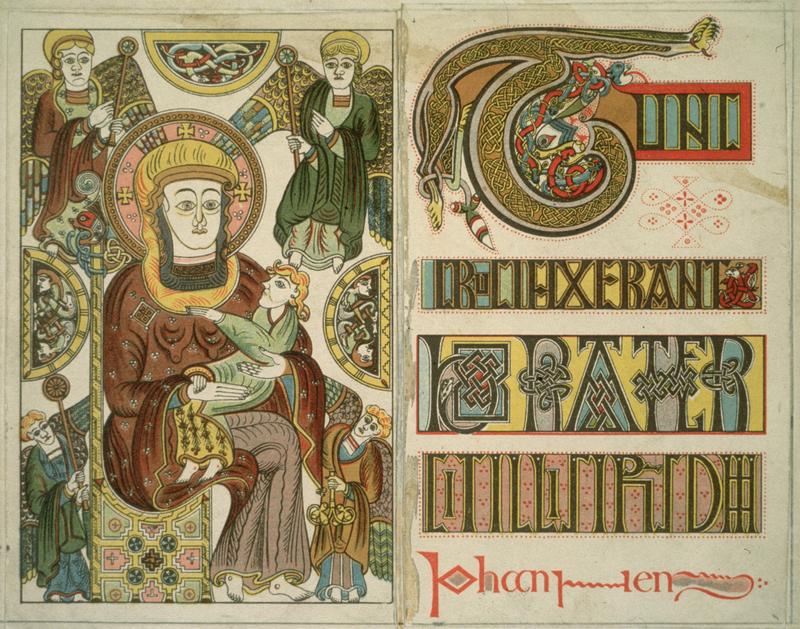Behold The Book Of Kells
By | November 7, 2019

One of history's greatest pieces of art and the finest example of the medieval illuminated manuscript is Ireland’s famous Book of Kells. It is one of the preeminent national treasures of Ireland.

Origins
The Book of Kells is believed to have been originally crafted circa 800 A.D. by monks at the monastery of Iona who made it in honor of Saint Columba who had founded the monastery. It was later moved to the monastery of Kells where it was probably later finished. The entire story of the origins of the Book of Kells is still debated with some arguing that it was created entirely at Kells or Iona. It will likely remain a mystery.

Description
The Book of Kells is an illuminated manuscript belonging to the Insular style such as the Lindesfarne Gospel and the Book of Darrow. Illuminated manuscripts are books that are decorated and interwoven with images that either help to explain the text or serve the purpose of glorifying God. This probably arose as the population grew more and more illiterate during that Middle Ages. The book contains 340 folios amounting to 680 pages and is made of calf vellum. It is 13 inches wide and 10 inches high. As to who made the Book of Kells, the answer is speculative. Most experts believe that there were three artists based on the various styles used through the work and four different scribes. It is also likely the book was created mostly for ceremonial purposes and display since there are errors and omissions in the text.
The book contains in Latin the four gospels of the Christian New Testament plus introductory matter. It was not unusual for monks to copy holy texts, it was considered an service to God to do so. What was unusual is the sheer artistry of the Book of Kells.

Artistry
The Book of Kells in comparison with other illuminated manuscripts is far more elaborate and intricately filled with images of animals, both real and fantastical, which seem to grow out of the pages. In some cases, the monks, never having seen the living version of the animal in the text, used artistic license so that the original animal is hard to recognize. The initials — that is the first letter of a chapter — are often the most strikingly ornate. Some of the images are purely ornamental, while others are steeped in Christian symbolism.

"Not of men, but of angels."
Giraldus Cambrensis described a book in 1185 which was likely the Book of Kells: "If you take the trouble to look very closely, and penetrate with your eyes to the secrets of the artistry, you will notice such intricacies, so delicate and subtle, so close together, and well-knitted, so involved and bound together, and so fresh still in their colourings that you will not hesitate to declare that all these things must have been the result of the work, not of men, but of angels."

History
The early history of the book is largely a mystery. The monastery at Kells was frequently subjected to Viking attacks, so how it passed through this phase of its life is unknown. The first historic mention of it is in 1007 when it was reported to be stolen. It turned up two months and twenty days later with its golden and bejeweled cover stolen and buried “with a sod over it.” Early visitors also wrote in the book, and pages were also used to record land charters onto blank pages. These, however, should not be considered defacement since it helped in being able to trace the history of the book.
The Book of Kells remained in Kells until 1654 when the cavalry of Oliver Cromwell stayed at Kells Abbey. The book was sent to Dublin for its safety. In 1661, Henry Jones, who would become the bishop of Meath presented it to Trinity College. It has remained there ever since with occasional excursions abroad for show.

A Top Draw
The book has been rebound several times in its history with the latest rebinding being in 1953 when restorers divided it into four volumes. The Book of Kells today is missing 30 pages — it is not known when over the centuries these have been lost.
The Book of Kells has been on permanent display at the Trinity College Library since the mid-nineteenth century. Typically two volumes are on display, one focusing on the art and the other on the typography. Its popularity for tourists has grown. In 2018, over one million visitors came to Trinity College to examine the book making it one of the top draws to Dublin.

